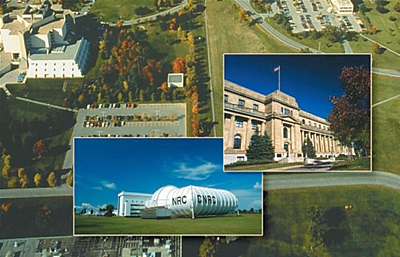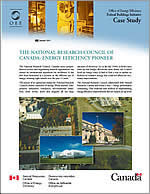ARCHIVED - The National Research Council of Canada: Energy Efficiency Pioneer
Information Archived on the Web
Information identified as archived on the Web is for reference, research or recordkeeping purposes. It has not been altered or updated after the date of archiving. Web pages that are archived on the Web are not subject to the Government of Canada Web Standards. As per the Communications Policy of the Government of Canada, you can request alternate formats. Please "contact us" to request a format other than those available.
The National Research Council, Canada's most comprehensive science and engineering research organization, has earned an international reputation for excellence. It has also been honoured as a pioneer in the efficient use of energy, winning eight awards over the past 11 years.
The nature of its operations makes the National Research Council a heavy consumer of energy. Wind tunnels, compressors, exhausters, ventilators, environmental chambers, clean rooms, lasers and magnets all use large amounts of electricity. So, in the late 1980s, as hydro rates went up and budget allocations went down, the Council faced an energy crisis. It had to find a way to update its facilities to conserve energy, but could not afford the necessary improvements.
The National Research Council collaborated with Natural Resources Canada and found a way – energy performance contracting. This relatively new method of implementing energy efficiency improvements did not require an up-front investment. Hence, the National Research Council became the first federal organization to enter into an energy management agreement with a private sector firm.

In 1989 the Council signed a five-year, $1.6-million contract with Rose Technology Group Limited (RTG) (now Vestar). Under the terms of the contract, the National Research Council did not have to put up any money. Instead, the energy service company would finance the needed improvements and later recoup its investment from the resultant savings in energy.
The project focused on four buildings with a total floor space of 61 000 m2 (657 000 sq. ft.). As part of its service, RTG first conducted an energy audit. By reviewing three years of utility bills (adjusting for weather and occupancy) before undertaking the retrofit, the company established an energy-use baseline for the buildings.
The most important improvements involved installing a centralized energy management control system, improving the lighting in buildings and retrofitting air-handling units. RTG, in collaboration with project manager Subash Vohra, specified and commissioned all the new equipment and trained National Research Council staff in its use.
Mr. Vohra, Director General of the Council's Administrative Services and Property Management Branch, says he was intrigued by the concept, but wasn't sure if the arrangement would work. He now describes it as a “smashing success.” The improvements led to savings of $400,000 a year, and the project had paid for itself even before the contract expired. For his leadership in the initiative, Mr. Vohra received the first Canada's Energy Efficiency Award.
- Building on success
- Incentive and inspiration
- All the help you need
- For more information
Inv. No.: M27-01-1431E
Page details
- Date modified:
